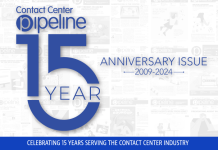
Time flies! Here we are at Back to School time … prepping back packs, planning schedules, assigning duties, and gathering tools needed for success. Back to School is a good time to reflect on your own knowledge of Contact Center management. Are there things you need to know, know better, or revisit? Knowledge is a living organism of sorts. It needs to be nourished and cared for to remain healthy, fresh, and abundant. This is as true for school students as it is for business leaders at every level. If memory serves me, a school year typically begins with a review of what was previously covered. So, I’d like to offer a review of Service Level (SL), including what it is and how it is best used.
“To know what you know and what you do not know, that is true knowledge.”
—Confucius
Overview
I became inspired to write about Service Level when I downloaded a report from a major award-winning Contact Center technology vendor. The report described Service Level as a KPI, a “percentage measurement of how well standards are met.” This meaning was not horrible until the report went on to use this example: “Ninety percent of calls answered in four rings.” Yikes! Phones stopped ringing in Contact Centers decades ago!
I have to say that I beg to differ with this vendor’s definition. I have been in this space since the 1980’s and to the best of my recollection no one operating a 21st century Contact Center quotes a Service Level objective in number of rings. I was surprised that a major player in the market offered this definition. Conversely, another vendor that is a relative newcomer to the U.S. market defines Service Level more appropriately “as the percentage of calls answered and missed within a predefined threshold, e.g., 20 seconds.”
Service Level as Planning Tool
While most descriptions/definitions of Service Level have elements of truth, its major and more complex purpose is often missed. Service Level must play a major role in PLANNING for all Contact Center resources, from staff to tools.
Service Level is primarily a planning tool. It highlights the fact that Contact Center management is both an art and science. The art of Service Level links it to strategic objectives and building a case for resource requirements while meeting strategic business goals. These may include Customer Experience, Efficiency/Cost, and Concierge or VIP treatment. At the same time, higher-ups must be educated as to the meaning of Service Level and its role in delivering on brand promises.
The science of Service Level is its role in Workforce Management (WFM) and the Erlang C formula. Erlang C is the mathematical formula used for staffing the Contact Center: Service Level is one of its four elements: Talk Time, After Call Work, Volume, and Service Level. These elements are used to forecast resources required to handle a particular load during a particular interval within the day. (See also July Pipeline Article, Carry That Load.)
If you have a Workforce Management System, Erlang C is the formula used. Those without a Workforce Management System can find Erlang C calculators available on the internet (http://powerhouse1.com/calculator/) to assist with a manual process. So yes, Service Level is a measurement and best used as a measurement of your plan and subsequently of your performance within that plan.
Defining Service Level
Service Level is a statement – X percentage of calls answered within Y seconds – as in 80% of calls answered in 20 seconds. An 80/20 Service Level is common for Customer Service operations. However, beware when selecting a Service Level and keep in mind: there is no industry standard service level! Why not?
First and foremost, there is no Contact Center governing body. Essentially, we are in an industry where anyone can claim anything as an industry standard or best practice. Contact Center leaders must take with a grain of salt any claim that something that is simply common is in fact a standard or a best practice.
Service Level objectives ideally represent the company’s strategic goals and the value of the call. It is also healthy to look at the cost of labor, caller tolerance, and the desire for marketplace differentiation. This is a decision best made by working backwards from your Customer Experience objectives to determining the Service Level that is right for you and your organization.
Many organizations have multiple Service Levels. The Sales line may have a very high Service Level (90/10) because the cost of resources is less than the revenue generated. On the other hand, the IT Help Line may have a low Service Level due to the cost of labor and caller tolerance.
Four Impact Areas
Service Level has four key impact areas that create a framework for making a case to senior management for resources required to meet strategic objectives. Forget about telling management that your funding objective is to meet Service Level. It is unlikely that leadership has any in-depth clue as to what that means.
Rather when making a case for resources, lead with the impact areas: Caller Delay, Abandon, Agent Occupancy, and Cost.
Caller Delay
Delay is the time a caller spends “on hold” in the queue before reaching an agent. It is determined by the number of agents available (i.e., hired, trained, and showing up). When forecasting delay, we face the delicate balance between needs of the business and needs of the consumer.
It is important to study history to demonstrate the role of Service Level in addressing various caller needs (e.g., VIP vs. IT). There are many reasons for varied Service Levels within one organization. Take the case of the Cancel My Service menu option for cell phone and cable providers. This option is often routed to a team with very high service levels in order to “recover” the customer rather than lose them. It is important to insert those needs into the planning process by using the appropriate Service Level. This provides the ability to forecast delays based on the Contact Center’s load, staff, and experience factors.
Abandon
Most higher-ups need to hear this: “Abandon is a response to a condition; it is not a condition in and of itself.” They also need to understand that abandonment is based on caller tolerance. Callers make decisions to remain on hold based on their unique need and motivation. (See also January Pipeline Article, The Fine Art of Contact Center Management.)
It must be understood that you cannot fix abandonment rates as they are simply an outcome. The fix lies in whatever part of the plan needs adjusting. It is likely to include things like improving cross-functional relationships. This is the opportunity to demonstrate via charts, graphs, etc., the data you have studied to conclude that abandons may be curbed by working with IT and making an investment in a faster network to reduce handle time. Or you might require that anyone companywide who wishes to publish the Contact Center’s number must first clear the timing, content, and tasks with the Contact Center planning team.
And just like Service Level, there are no industry standard “abandon” rates as situations and tolerances vary widely. You must study patterns to improve and communicate forecasts.
Agent Occupancy
Occupancy is the amount of time the agent is utilized (busy) handling calls and work associated with that call. Occupancy is impacted by proper scheduling to meet the “load.” This includes agents adhering to schedules, agent availability, shrinkage accuracy, size of the Center (smaller Contact Centers have lower occupancy), and Service Level.
When a queue (e.g., VIP or Concierge line) is going to be assigned a high Service Level, tradeoffs must be communicated. Occupancy or per agent productivity will be lower. Also, smaller Contact Centers see lower productivity at mid- to high-range Service Levels. So be particularly careful of anyone who publishes anything about “standards” for number of calls handled per agent as an objective (which is a bad idea no matter how you use it).
Larger Contact Centers with mid to high Service Levels will see higher occupancy at the agent level. When planning is underway, you must determine what is an acceptable occupancy target. Most organizations operate between 70% at the low end and 90% at the high end. Occupancy is impacted by the number of agents scheduled. When agents are tardy or absent that load is reallocated to those who come to work; hence their occupancy goes up and likely Service Level goes down. The plan has been damaged by no shows. It is important that everyone in the chain understands this dynamic.
Cost
The higher the Service Level the higher the cost. Higher Service Levels are achieved through additional agents per shift and/or improved processes or performance that reduce call handle time. In revenue-based environments, the additional cost of staff or technology investments is offset by gains in revenue.
Lead with something more interesting during budget season: “With this budget we intend to impact Customer Experience, Frontline Agent Experience, Cost, and (when appropriate) Revenue Objectives.”
When you think of Back to School reviews that kick off a student’s school year, why not add a review of how your Contact Center uses Service Level during this back to school season. Is Service Level used as a primary planning tool? Is it a means to educate and influence senior management? It is what you make it, so make it count!



